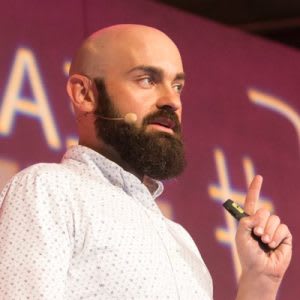Nick Means
Nickolas is VP of Engineering at MedScout.
Nickolas Means loves nothing more than a story of engineering triumph (except maybe a story of engineering disaster). He’s a student of building healthy culture for technical teams and thinks we have a lot to learn from those who have come before us. He hails from Austin, TX, and spends his spare time hanging out with his wife and kids, building keyboards, and pursuing the perfect cup of coffee.
Lost and alone over the Pacific
On December 22, 1978, veteran US Navy pilot Jay Prochnow found himself lost over the Pacific after a navigation failure during a solo ferry flight. With no land in sight and nightfall approaching, he had to find a way to survive. This is the story of how he navigated out of the crisis – and what we can learn from his experience.
The perils of context switching
Studies show that it can take 20 minutes to regain focus after a distraction, but what can engineering leaders do to help engineers switch context less often and find flow?
Ice, confusion, and the 38,000ft crash
Uncover the critical lessons from AF 447’s final moments – how small factors spiraled into disaster and what it teaches us about building resilient systems.
You are here: The story of the Barbican
If you were standing in this exact spot in early 1941, you’d be surrounded by rubble. Large swaths of London lie in ruins after the months-long Blitz during World War II, and Cripplegate ward where we now sit was almost completely destroyed. The only building you’d see standing would be a heavily damaged St. Giles Church.
You can’t actually “do more with less”
The unrealistic expectation of doing more with less has swept through the ranks of the tech industry. How can you maintain efficiency without burning out?
Embracing cycles of productivity for healthier teams
It’s common to equate working at 100% capacity to elevated productivity, but this isn’t true. Nick Means has some ways you can approach team efficiency in a healthier way.
The Three C’s of Company-Wide Collaboration
Nick Means digs into the three crucial things every company can holistically invest in to build an environment that fosters healthy collaboration across their entire organization.
Three ways to optimize team focus
Scheduling, prioritizing, and context-switching issues may be getting in the way of your team’s productivity. Here are three approaches to overcome these hurdles.
The 9.1 magnitude meltdown at Fukushima
Nick Means takes us to mid-afternoon on Friday, March 11, 2011 when the ground in Tōhoku began to shake. To the operators at Fukushima Daiichi nuclear power plant, it seemed like the shaking would never stop. The way their team operated during that fateful week has a lot to teach us about helping our own teams be at their best, both in crisis and out.
Values: The runbook for leadership
Using values you believe in as a runbook for difficult situations can make you a more consistent leader and help you build a healthier team.
The three secrets to building successful engineering and product relationships
How to collaborate effectively with product teams
How to run a great retrospective
Accelerating your team with regular, productive retrospectives
Taking the 737 to the MAX!
Nick Means uses the power of systems thinking to dig into how things could’ve gone so wrong (and learn to better see and understand the systems we interact with every day).
Pandemic and purpose-built remote work are not the same thing
What we can learn from purpose-built remote companies
The night the lights went out in Texas
How does the historic power outage relate to engineering leadership?
How to crash an airplane
On July 19, 1989, United Airlines Flight 232 was en route to Chicago when a mechanical failure caused the plane to become all but uncontrollable. In this unsurvivable situation, the flight crew saved more than half of those onboard. How did they do it?
The Original Skunk Works
Long before Agile and Lean became buzzwords, a scrappy group of aerospace engineers at Lockheed's Skunk Works were using similar practices to produce some of the most amazing aircraft ever built.
The building built on stilts
In the summer of 1978, structural engineer William LeMessurier got a phone call that terrified him. An undergraduate student claimed that LeMessurier’s acclaimed 59-story Citicorp Center in Manhattan, just completed the year prior, was dangerously unstable under certain wind conditions. The student was right, and it was almost hurricane season.
Who Destroyed Three Mile Island?
On March 28, 1979, at exactly 4 o’clock in the morning, control rods slammed into the reactor core of Three Mile Island Unit #2, halting the nuclear reaction because of a fault in the reactor cooling system.
Eiffel's tower
When Gustave Eiffel built his namesake tower, it was nearly twice as tall as the tallest structure on Earth.
Leverage your expertise to excel as an engineering leader
Prioritization on a deeper level
Learning to love meta productivity
Finding the satisfaction in management that you might have been missing from your years as a developer
The race to Mach 2.0 at scale
When Chuck Yeager became the first pilot to fly faster than the speed of sound, he set off a race around the world to do the same with a plane full of paying passengers. The United States, Russia, the UK, and France all wanted a piece of the inevitable fortune to be made building aircraft to cross oceans faster than sound itself.
Eiffel's Tower
When Gustave Eiffel built his namesake tower, it was nearly twice as tall as the tallest structure on Earth. His crews built it in an astounding 22 months, pioneering new construction techniques to deliver it in time for the opening of the 1889 Exposition Universelle. It was amazing then, and it’s just as captivating today.
